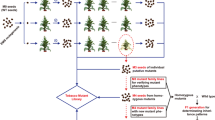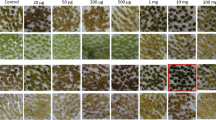Summary
Tobacco cell lines selected for resistance to picloram (4-amino-3,5,6-trichloropicolinic acid) and plants regenerated from these cell lines manifest several traits not shown by the parental strains. Genetics analyses of the regenerated plants have permitted the sources of this variability to be identified.
Tricotyledenous seedlings appeared at a much higher frequency among the progeny of a heterozygous mutant plant (PmR1/+) regenerated from culture than they did among progeny of normal regenerated plants. In crosses with the regenerated heterozygous mutant plant and with homozygous progeny of this plant (PmR1/PmR1) the frequency of tricotyly was influenced more by the generation than by the genotype of the parent plant. Therefore, it is concluded that tricotyly is a physiological response to passage through cell culture.
More than half of the picloram-resistant cell lines isolated were also resistant to hydroxyurea. Segregation of these two resistances was analyzed in progeny of crosses with regenerated plants. In all cases hydroxyurea-resistance was genetically stable and inherited as a single dominant nuclear mutation (designated HuR). In crosses with plants PmR1/+ and PmR7/+ the HuR and PmR mutations assorted independently. In contrast, the HuR mutation recovered from plant PmR6/+ was linked to the PmR6 mutation.
Similar content being viewed by others
References
Bayliss MW (1973) Origin of chromosome number variation in cultured plant cells. Nature London New Biol 246:529–530
Bayliss MW (1975) The effects of growth in vitro on the chromosome complement of Daucus carota (L.) suspension cultures. Chromosoma 51:401–411
Binns A, Meins F (1973) Habituation of tobacco pith cells for factors promoting cell division is heritable and potentially reversible. Proc Natl Acad Sci USA 70:2660–2662
Butenko RG, Shamina ZB, Frolova LV (1967) The induced organogenesis in a culture of tobacco stem pith callus and the characterization of the plants obtained from the tissue cultures of tobacco varieties. Genetika 3:29–39
Chaleff RS (1980) Further characterization of picloram-tolerant mutants of Nicotiana tabacum. Theor Appl Genet 58:91–95
Chaleff RS, Parsons MF (1978) Direct selection in vitro for herbicide-resistant mutants of Nicotiana tabacum. Proc Natl Acad USA 75:5104–5107
Collins GB, Vian WE, Phillips GC (1978) Use of 4-amino-3,5,6-trichloropicolinic acid as an auxin source in plant tissue cultures. Crop Sci 18:286–288
De Vries H (1910) The Mutation Theory. II. The origin of varieties by mutation. Open Court, Chicago
Haskell G (1954) Pleiocotyly and differentiation within angiosperms. Phytomorph 4:140–152
Heinz DJ, Krishnamurthi M, Nickell LG, Maretzki A (1977) Cell, tissue, and organ culture in surgarcane improvement. In: Reinert J and Bajaj YPS (eds) Applied and fundamental aspects of plant cell, tissue, and organ culture. Springer-Verlag, Berlin-Heidelberg-New York, p 3
Kefford NP, Caso OH (1966) A potent auxin with unique chemical structure-4-amino-3,5,6-trichloropicolinic acid. Bot Gaz 127:159–163
Lutz A (1977) Les manifestations organogènes de colonies tissulaires d'origine unicellulaire issues d'une souche anergiée de tabac. In: Gautheret RJ (ed) La Culture des Tissus et des Cellules des Végétaux. Masson, Paris, p 124
Orton TJ (1980) Chromosomal variability in tissue cultures and regenerated plants of Hordeum, Theor. Appl. Genet. 56:101–112
Sacristán MD (1971) Karotypic changes in callus cultures from haploid and diploid plants of Crepis capillaris (L.) Wallr. Chromosoma (Berl) 33:273–283
Sacristán MD, Melchers G (1969) The caryological analysis of plants regenerated from tumorous and other callus cultures of tobacco. Mol Gen Genet 105:317–333
Shepard JF, Bidney D, Shahin E (1980) Potato protoplasts in crop improvement. Science 208:17–24
Skirvin RM (1978) Natural and induced variation in tissue culture. Euphytica 27:241–266
Skirvin RM, Janick J (1976) Tissue culture-induced variation in secented Pelargonium spp. J Amer Soc Hort Sci 101:281–290
Sunderland N (1977) Nuclear cytology. In: Street HE (ed) Plant tissue and cell culture. Univ of California, Berkeley, p 177
Author information
Authors and Affiliations
Additional information
Communicated by G.R. Fink
Rights and permissions
About this article
Cite this article
Chaleff, R.S., Keil, R.L. Genetic and physiological variability among cultured cells and regenerated plants of Nicotiana tabacum . Molec. Gen. Genet. 181, 254–258 (1981). https://doi.org/10.1007/BF00268434
Received:
Issue Date:
DOI: https://doi.org/10.1007/BF00268434




